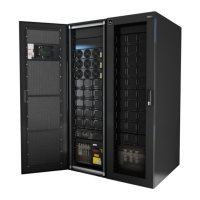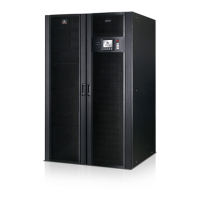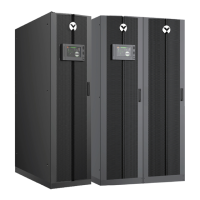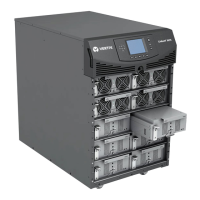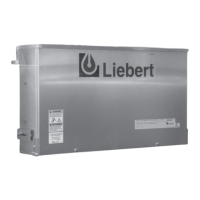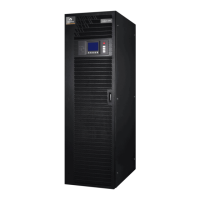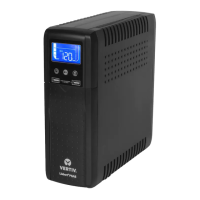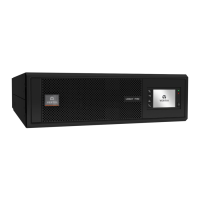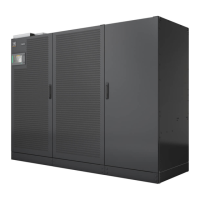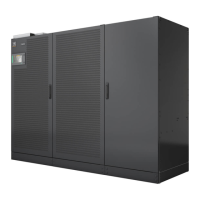Do you have a question about the Vertiv Liebert APM Plus and is the answer not in the manual?
Safety precautions for personnel handling the UPS.
Safety precautions for the UPS product itself.
Vertiv's disclaimer regarding product use and information provided.
General safety guidelines and warnings for UPS operation and installation.
Compliance with European and international safety and EMC standards.
Key features and advantages of the Vertiv Liebert APM Plus UPS system.
Explanation of the UPS's design concept and working principle.
Information on connecting multiple UPS units for parallel operation and redundancy.
Description of the various operating modes available for the UPS.
Functions related to battery management, charging, and monitoring.
Safety features and protection mechanisms for the UPS battery system.
Important precautions and considerations for UPS mechanical installation.
Guidelines and recommendations for safely transporting the UPS equipment.
List of recommended tools required for UPS installation.
Step-by-step instructions for unpacking the UPS and battery packages.
Procedures for performing an initial inspection before UPS installation.
Specifications and requirements for the UPS installation environment.
Mechanical specifications and clearance requirements for the UPS.
Diagrams illustrating UPS installation dimensions, views, and cabling.
Procedures and guidelines for wiring power cables to the UPS system.
Procedures and guidelines for wiring signal cables to the UPS system.
Overview of the UPS touchscreen control panel interface and its functions.
How to navigate and utilize the features of the touchscreen control panel.
Procedures for operating the UPS via the touchscreen control panel, including commands.
Methods for monitoring the UPS status, including gauges, panels, and logs.
How to view the status of individual UPS components through the interface.
Understanding the status bar messages, icons, and color indicators.
Comprehensive list of UPS alarm messages and their explanations for troubleshooting.
Introduction to single UPS module operations, including essential precautions.
Step-by-step instructions for starting the UPS in normal, ECO, and battery modes.
How to transfer the UPS between different operating modes like Normal, Bypass, and Maintenance.
Procedures for performing battery self-tests and maintenance tests.
Instructions for safely powering down the UPS system completely or while maintaining load.
Emergency Power Off (EPO) procedures for immediate UPS shutdown.
Steps to reset the UPS after an EPO event or fault for normal operation.
Explanation of the automatic restart function after power restoration or EOD.
Steps to change the display language on the UPS control panel.
Procedures to set the system date and time on the UPS control panel.
How to change user passwords for different UPS access levels.
Introduction to UPS batteries, their safety, installation, and maintenance.
Critical safety precautions and warnings when working with UPS batteries.
Information about the type, characteristics, and recommendations for UPS batteries.
Important considerations and precautions for the design of battery installations.
Requirements for the battery installation environment and cell configuration.
Protection mechanisms for UPS batteries against short circuits, overloads, and over-discharge.
Step-by-step guide for installing and connecting UPS batteries to the system.
Guidelines for designing a safe and effective battery room with proper layout and wiring.
Functionality and connection of common battery strings for parallel systems to save space and improve efficiency.
Details on the optional BCB cabinet for battery protection and isolation, particularly for APAC.
Information on the optional battery temperature sensor for monitoring and compensation.
Optional detector for identifying and alerting on battery ground faults.
Recommended BCB current ratings and connection details for battery protection.
Procedures and precautions for regular battery maintenance to ensure optimal performance and longevity.
Guidelines for the proper and regulatory disposal of used UPS batteries.
General overview of parallel UPS systems and Load Bus Synchronizer (LBS) systems.
Procedures for installing parallel UPS systems and LBS systems.
Operating procedures for parallel UPS systems, including startup, maintenance, and isolation.
Details about the Load Bus Synchronizer (LBS) system, including its cabinet installation.
A list of available optional accessories and features for the UPS system.
Introduction and details regarding the installation and configuration of various UPS options.
How to use SNMP for UPS network monitoring and management using UNITY or SIC cards.
Utilizing Modbus protocol for UPS communication and data exchange.
Communication methods utilizing dry contact signals via IS-Relay card or bypass module ports.
Essential safety guidelines and warnings for personnel performing UPS service and maintenance.
Procedures for servicing and replacing the power and bypass modules of the UPS.
Information on key UPS components, their estimated service life, and replacement intervals.
General maintenance practices and recommendations for the UPS and its optional accessories.
Compliance of the UPS with relevant European and international standards.
Environmental operating conditions, noise levels, and temperature specifications for the UPS.
Physical dimensions, weight, and protection degree specifications for the UPS.
Electrical input specifications, including voltage, frequency, and current for the rectifier.
Electrical specifications for the intermediate DC circuit, including battery voltage and charging parameters.
Electrical specifications for the UPS inverter output, including voltage, frequency, and overload capability.
Electrical specifications for the UPS bypass input, including voltage and frequency tolerance.
UPS efficiency ratings in different modes and power loss information.
Definitions of technical terms used throughout the UPS manual.
Information on hazardous substances present in the product's components according to regulations.
Guidelines for the proper and regulatory disposal of the UPS and its components in India.
Safety precautions for personnel handling the UPS.
Safety precautions for the UPS product itself.
Vertiv's disclaimer regarding product use and information provided.
General safety guidelines and warnings for UPS operation and installation.
Compliance with European and international safety and EMC standards.
Key features and advantages of the Vertiv Liebert APM Plus UPS system.
Explanation of the UPS's design concept and working principle.
Information on connecting multiple UPS units for parallel operation and redundancy.
Description of the various operating modes available for the UPS.
Functions related to battery management, charging, and monitoring.
Safety features and protection mechanisms for the UPS battery system.
Important precautions and considerations for UPS mechanical installation.
Guidelines and recommendations for safely transporting the UPS equipment.
List of recommended tools required for UPS installation.
Step-by-step instructions for unpacking the UPS and battery packages.
Procedures for performing an initial inspection before UPS installation.
Specifications and requirements for the UPS installation environment.
Mechanical specifications and clearance requirements for the UPS.
Diagrams illustrating UPS installation dimensions, views, and cabling.
Procedures and guidelines for wiring power cables to the UPS system.
Procedures and guidelines for wiring signal cables to the UPS system.
Overview of the UPS touchscreen control panel interface and its functions.
How to navigate and utilize the features of the touchscreen control panel.
Procedures for operating the UPS via the touchscreen control panel, including commands.
Methods for monitoring the UPS status, including gauges, panels, and logs.
How to view the status of individual UPS components through the interface.
Understanding the status bar messages, icons, and color indicators.
Comprehensive list of UPS alarm messages and their explanations for troubleshooting.
Introduction to single UPS module operations, including essential precautions.
Step-by-step instructions for starting the UPS in normal, ECO, and battery modes.
How to transfer the UPS between different operating modes like Normal, Bypass, and Maintenance.
Procedures for performing battery self-tests and maintenance tests.
Instructions for safely powering down the UPS system completely or while maintaining load.
Emergency Power Off (EPO) procedures for immediate UPS shutdown.
Steps to reset the UPS after an EPO event or fault for normal operation.
Explanation of the automatic restart function after power restoration or EOD.
Steps to change the display language on the UPS control panel.
Procedures to set the system date and time on the UPS control panel.
How to change user passwords for different UPS access levels.
Introduction to UPS batteries, their safety, installation, and maintenance.
Critical safety precautions and warnings when working with UPS batteries.
Information about the type, characteristics, and recommendations for UPS batteries.
Important considerations and precautions for the design of battery installations.
Requirements for the battery installation environment and cell configuration.
Protection mechanisms for UPS batteries against short circuits, overloads, and over-discharge.
Step-by-step guide for installing and connecting UPS batteries to the system.
Guidelines for designing a safe and effective battery room with proper layout and wiring.
Functionality and connection of common battery strings for parallel systems to save space and improve efficiency.
Details on the optional BCB cabinet for battery protection and isolation, particularly for APAC.
Information on the optional battery temperature sensor for monitoring and compensation.
Optional detector for identifying and alerting on battery ground faults.
Recommended BCB current ratings and connection details for battery protection.
Procedures and precautions for regular battery maintenance to ensure optimal performance and longevity.
Guidelines for the proper and regulatory disposal of used UPS batteries.
General overview of parallel UPS systems and Load Bus Synchronizer (LBS) systems.
Procedures for installing parallel UPS systems and LBS systems.
Operating procedures for parallel UPS systems, including startup, maintenance, and isolation.
Details about the Load Bus Synchronizer (LBS) system, including its cabinet installation.
A list of available optional accessories and features for the UPS system.
Introduction and details regarding the installation and configuration of various UPS options.
How to use SNMP for UPS network monitoring and management using UNITY or SIC cards.
Utilizing Modbus protocol for UPS communication and data exchange.
Communication methods utilizing dry contact signals via IS-Relay card or bypass module ports.
Essential safety guidelines and warnings for personnel performing UPS service and maintenance.
Procedures for servicing and replacing the power and bypass modules of the UPS.
Information on key UPS components, their estimated service life, and replacement intervals.
General maintenance practices and recommendations for the UPS and its optional accessories.
Compliance of the UPS with relevant European and international standards.
Environmental operating conditions, noise levels, and temperature specifications for the UPS.
Physical dimensions, weight, and protection degree specifications for the UPS.
Electrical input specifications, including voltage, frequency, and current for the rectifier.
Electrical specifications for the intermediate DC circuit, including battery voltage and charging parameters.
Electrical specifications for the UPS inverter output, including voltage, frequency, and overload capability.
Electrical specifications for the UPS bypass input, including voltage and frequency tolerance.
UPS efficiency ratings in different modes and power loss information.
Definitions of technical terms used throughout the UPS manual.
Information on hazardous substances present in the product's components according to regulations.
Guidelines for the proper and regulatory disposal of the UPS and its components in India.
| Input Frequency | 50/60 Hz |
|---|---|
| Output Voltage | 380/400/415V AC |
| Output Frequency | 50/60 Hz |
| Phase | 3-phase |
| Topology | Double Conversion |
| Battery Type | Valve-regulated lead-acid (VRLA) |
| Communication Interfaces | SNMP, Modbus |
| Dimensions (HxWxD) | Varies by model |
| Weight | Varies by model |
| Operating Temperature | 0 to 40°C |
| Humidity | 0-95% non-condensing |
| Product Type | Uninterruptible Power Supply (UPS) |
